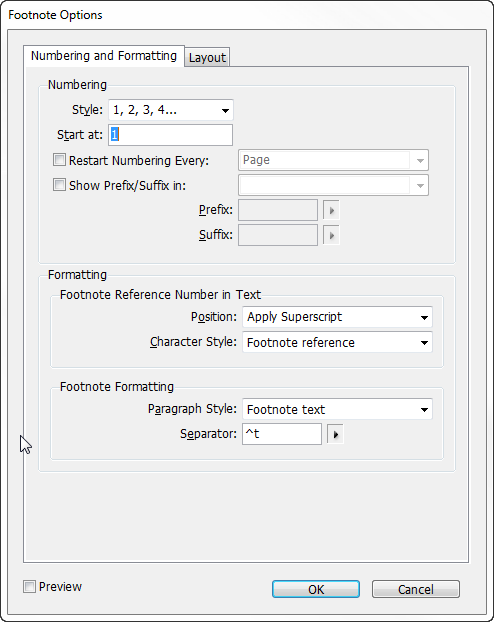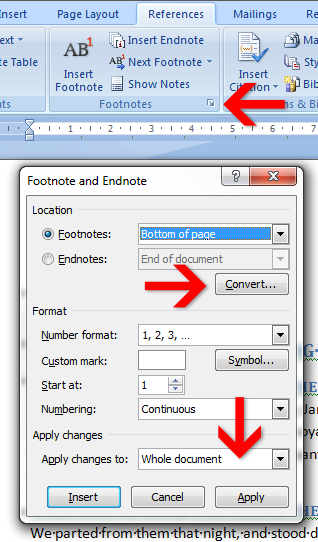Received an email today in which the following question was asked:
“Is there an InDesign add-on that you know of that a) can take static endnotes and transform them to dynamic (i.e. linked) footnotes and b) can change static endnotes to dynamic endnotes”.
Updated 13-Nov-2010, added Footnotes Note.
InDesign has support for dynamic footnotes. This means that the application retains a connection between the footnote reference (the in-text reference) and the footnote text. InDesign, however lacks support for dynamic endnotes.
Microsoft Word into InDesign
What does this mean for publishers who are placing manuscript text set in Microsoft Word containing footnotes or endnotes into InDesign?
When we display the Import Options during Word document import (File > Place) we can import both footnotes and endnotes:
- Select the Footnotes and Endnotes check boxes
- Click OK.
Footnotes
The footnotes will import as dynamic footnotes, with the exception of footnotes that were included in tables in Word and footnotes that were included inside footnote text. Their footnote reference remains visible in the InDesign file as a static number, but the footnote text vanishes.
Regardless of how you import the styles and formatting from Word, it is a good idea to set-up a character style for the footnote reference text and a paragraph style for the footnote text. If you opt to import Styles and Formatting from Text and Tables on the fly from Word, you’ll end-up with two styles you can use immediately: a Paragraph Style called Footnote text and a Character style called Footnote reference.
Assign these two styles in InDesign’s Document Footnote Options (Type > Document Footnote Options).
Note: Although the document footnote options for an InDesign document can reset footnote numbering based on Page, Spread or Section. Each individual story will always cause a footnote numbering reset. In other words for continuous footnote numbering within a chapter (Section), you’d need to ensure all text frames within the chapter are threaded. Rorohiko has developed a nice tool for InDesign that can help you thread text frames for this purpose: http://www.rorohiko.com/wordpress/indesign-downloads/textstitch/
Endnotes
Endnotes import as static endnotes. I’d opt to import Styles and Formatting from Text and Tables on the fly from Word, as all endnote references — including those inserted in tables— will have the Endnote reference Character style applied to it. A Paragraph Style called Endnote text is applied to the endnote text at the end of the story.
Story: a series of threaded text frames in InDesign.
Converting static endnotes to footnotes
We now get to the first part of the question. If your source Word document contains endnotes and you’d like to import those as dynamic footnotes in InDesign, the easiest things to do — in my opinion — is convert the endnotes into footnotes in the source Word document, prior to its placement into InDesign.
Keep in mind however, that there are limitations as to where footnote references are supported in InDesign. If endnotes appear in tables in Word and are converted to footnotes in Word, they will be ignored during the document import into InDesign.
I am not aware of any script that’s out there that performs this conversion from static endnotes to dynamic footnotes in InDesign. But could very well be overlooking a script. Let me know if there is a script that does this in InDesign. I’d gladly add the details to this post.
Converting static endnotes to dynamic endnotes
As to conversion of static endnotes to dynamic endnotes… This is an easier question to this answer. Peter Kahrel developed an excellent free script for InDesign that does just that. Ok, it doesn’t quite add a true dynamic endnote feature to InDesign, but the script builds InDesign cross-references based on the paragraph and character style information the document contains, when a paragarph style is applied to endnote text and a character style is applied to the endnote reference. Creating cross-references means that the link between endnote reference and text does become dynamic. Which makes it a script that is very useful in the interactive PDF and EPUB arena.
Note: You might find you need to go through the endnote text at the end of a story and remove remove blank paragraph returns first in the endnote text and reapply the endnote text paragraph style to the endnotes prior to running the script — I ran some tests with the latest version at time of writing, and encountered a small issue with an imported Word 2007 document where blank returns appeared between the endnote text paragraphs and the script thought there was a different number of endnote references to end note text.
You can read further instructions on how it to install and use the script on Peter’s web-site:
http://www.kahrel.plus.com/indesign/dynamic_endnotes.html
Additional Word to InDesign Endnote support
If what you are looking for is a solution that adds better support for Microsoft Word endnotes in InDesign, then there is a commercial plug-in available as well: Sonar Bookends InFnote from Virginia Systems. You basically place a Word document including the Endnotes into InDesing, then run an Import Word Endnote command and place the endnotes in a separate InDesign text frame (no longer attached to the story) and update the numbering.
You can download demo version of the script that includes the user manual from the Virginia Systems web-site:



so how to make a book if you can’t make footnotes in tables? there are over 300 footnotes!
If all if the footnotes are set in tables, you could consider developing/using a script that generates footnote frames at the bottom of each page.
Hi Cari
Long time no speak!
I have a client that has stacks of product information in tables. And they need footnotes!
So here we are in 2015 and ID CC still has no support for this.
To your knowledge has anybody ever written a script? I have done 1 h of google work and the usual suspects all have something to say but nothing I would call a solution.
All the best
hi Romano, for linkable footnotes in tables, have you considered using cross-references? E.g. create a new numbered list specific for the footnotes.
Paragraph style that uses the numbers, and than define a cross-reference that only inserts the numbers (not the paragraph text). Cheers, Cari
You can also use cross-references, that use a numbered paragraph style. I use this trick a lot when I need to span footnotes across columns and continue footnote numbering across stories.
Thanks for some great tips! I wish the thorny issue of footnotes in tables could be addressed in this article. And I wish the Restart Numbering options in the Footnote preferences could be adapted to help fix the table/footnote problem. As it is now, it is a real headache.
@Anon 🙂 I’m hoping that one day the Adobe InDesign Engineering team will review the footnote feature and add all the functionality we are currently missing… e.g. the ability to span footnotes across columns, support footnotes in tables, and continue numbering footnotes across stories… There are scripts out there that will help out. Have a look at Peter Kahrel’s scripts for footnotes/endnotes. Some might help you out.
Many thanks – have puzzled over how to bring footnotes in automatically and had not thought of File -> Place! (I usually think of PLace as to do with graphics …).